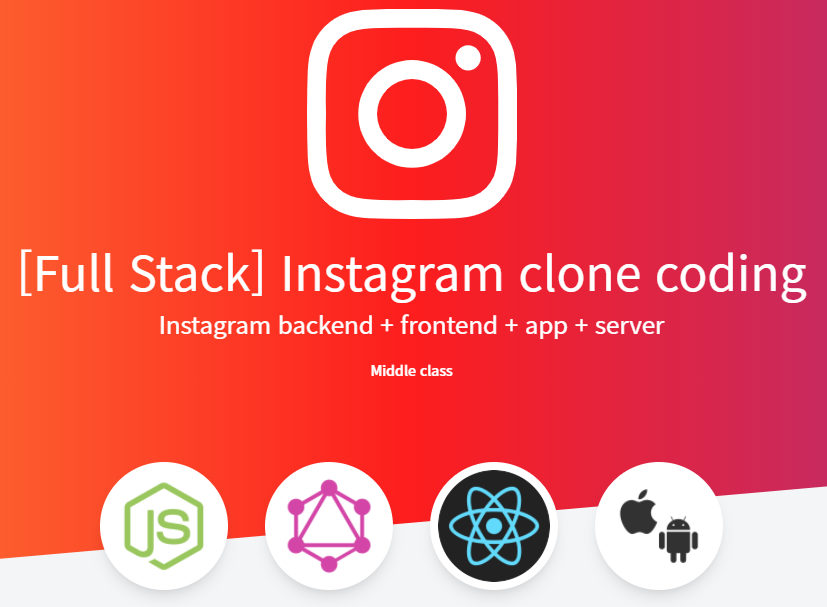Description
Instagram clone coding is the name of a full-stack project-based training course for creating a program similar to Instagram (including back-end, front-end, application and server). The term clone coding refers to a completely educational and practical method, with the help of this educational method you will learn coding by following real services such as Instagram, KakaoTalk and YouTube.
What you will learn in the Instagram Clone Coding course:
- Functions related to users include email login, user profiles, follow and direct
- Functions related to images include image search, image liking, image feeds and image upload
- Navigation, working with camera, accessibility and Geolocation
- Heroku and Netlify development
Course details
Publisher: Nomad Coders (nomadcoders)
Instructors: (니꼬) Niko
English language
Training level: introductory to advanced
Number of courses: 139
Duration: 20 hours and 47 minutes
Headlines of the Instagram Clone Coding course:
2 INTRODUCTION
2.0 Welcome!
2.1 Requirements
3 BACKEND SETUP
3.0 Setup
3.1 Apollo Server
3.2 Babel
3.3 POC API
3.4 Prisma Setup
3.5 Prisma Migrate
3.6 Prisma Client
3.7 Prisma Client Part Two
3.8 Prisma Studio
3.9 Architecture part one
3.10 Architecture part two
3.11 Dotenv
3.12 Recap
4 USER MODULE
4.0 Create Account part On
4.1 Create Account part two
4.2 Create Account part three
4.3 seeProfile
4.4 login
4.5 login part two and refactor
4.6 Divide and Conquer
4.7 updateProfile
4.8 authentication part one
4.9 authentication part two
4.10 authentication part three
4.11 Protecting Resolvers part One
4.12 Protecting Resolvers part two
4.13 Recap
4.14 File Upload part One
4.15 File Upload part two
4.16 File Upload part three
4.17 File Upload part Four
4.18 Ejecting from Apollo Server
4.19 Changing Avatar
4.20 Followers part one
4.21 Following User
4.22 Unfollow User and See Followers
4.23 Followers Pagination part one
4.24 Followers Pagination part two
4.25 Following Pagination
4.26 Computed Fields part One
4.27 Computed Fields part two
4.28 Computed Fields part three
4.29 Searching Users
5 TS SETUP
5.0 TS Setup part One
5.1 TS Setup part two
6 PHOTO MODULE
6.0 Photos Model
6.1 Prisma Fields vs SQL Fields
6.2 Upload photo part one
6.3 Upload photo part two
6.4 Upload photo part three
6.5 seePhoto
6.6 seeHashtag
6.7 edit Photo part One
6.8 edit Photo part Two
6.9 Like Unlike Photos
6.10 Like Unlike Photos part two
6.11 seeLikes
6.12 seeFeed
6.13 Comment on Photos
6.14 See Photo Comments
6.15 isMine
6.16 Delete Comments and Photos
6.17 editComment
6.18 protectedResolver Refactor
6.19 S3 Photo Upload
6.20 S3 Photo Upload part Two
6.21 S3 Photo Upload part three
7 DIRECT MESSAGES
7.0 Introduction
7.1 Models
7.2 seeRooms
7.3 sendMessage
7.4 seeRoom
7.5 readMessage
7.6 Supertest
7.7 Subscriptions Setup part One
7.8 Subscriptions Setup part Two
7.9 Filtering Subscriptions part one
7.10 Filtering Subscriptions part two
7.11 Authenticating Subscriptions
7.12 Recap
8 FRONTEND SETUP
8.0 Create React App
8.1 Installing All
8.2 What Does Setup Mean?
8.3 Router Setup part One
8.4 Router Setup part two
8.5 Auth POC
8.6 Reactive Variables
8.7 Introduction to Styled Components
8.8 Themes on Styled Components
8.9 GlobalStyles on Styled Components
9 FRONTEND TS SETUP
9.0 Styled Components
9.1 React Hook Form
9.2 GraphQL
10 LOGIN AND SIGNUP
10.0 Introduction
10.1 Login UI Clone
10.2 Cleaning Login Code
10.3 Shared Components
10.4 Sign Up UI
10.5 Forms in React
10.6 Helmet Components
10.7 React Hook Form
10.8 React Hook Form is Awesome
10.9 Apollo Client
10.10 Login part One
10.11 Login part two
10.12 Create Account
10.13 Redirecting Users
10.14 Dark Mode
11 FEED
11.0 Header and Layout
11.1 Header part two
11.2 Header part three
11.3 Avatars
11.4 Photo Component Part One
11.5 Photo Component Part Two
11.6 isLiked
11.7 Liking Photos
11.8 Refetching Queries
11.9 writeFragment
11.10 readFragment
11.11 Comments part one
11.12 Comments part two
11.13 Parsing Hashtags
11.14 Parsing Hashtags part two
11.15 cache Modify
11.16 Create Comment part One
11.17 Create Comment part two
11.18 Create Comment part three
11.19 Delete Comment
12 PROFILE
12.0 useParams
12.1 Queries and Fragments
12.2 keyFields
12.3 Follow Unfollow part One
12.4 Follow Unfollow part Two
12.5 Follow Unfollow part three
12.6 Follow Unfollow part Four
12.7 Follow Unfollow part Five
12.8 Web Conclusions
Instagram Clone Coding course prerequisites:
Beginner or higher vanilla JS understanding is required.
Beginner level or higher understanding of REACT JS is required.
Requires beginner level or higher understanding of REACT NATIVE.
Intermediate or higher understanding of GRAPHQL and APOLLO is required.
Images of Instagram Clone Coding:
Sample video of Instagram Clone Coding course:
Installation guide
After Extract, view with your favorite Player.
Subtitle: None
Quality: 1080p
Title of the course in Korean: (터스타) INSTAGRAM Clone coding
Attention: The course instructor teaches in English. (According to the sample video)
download link
Password file(s): www.downloadly.ir
Size
44.4 GB
